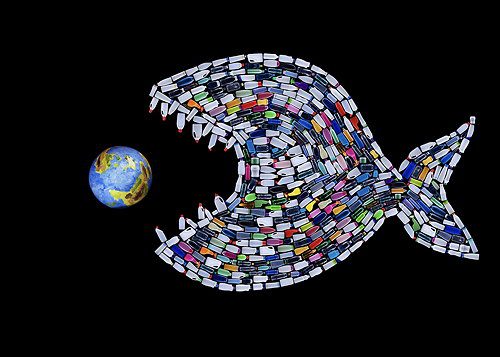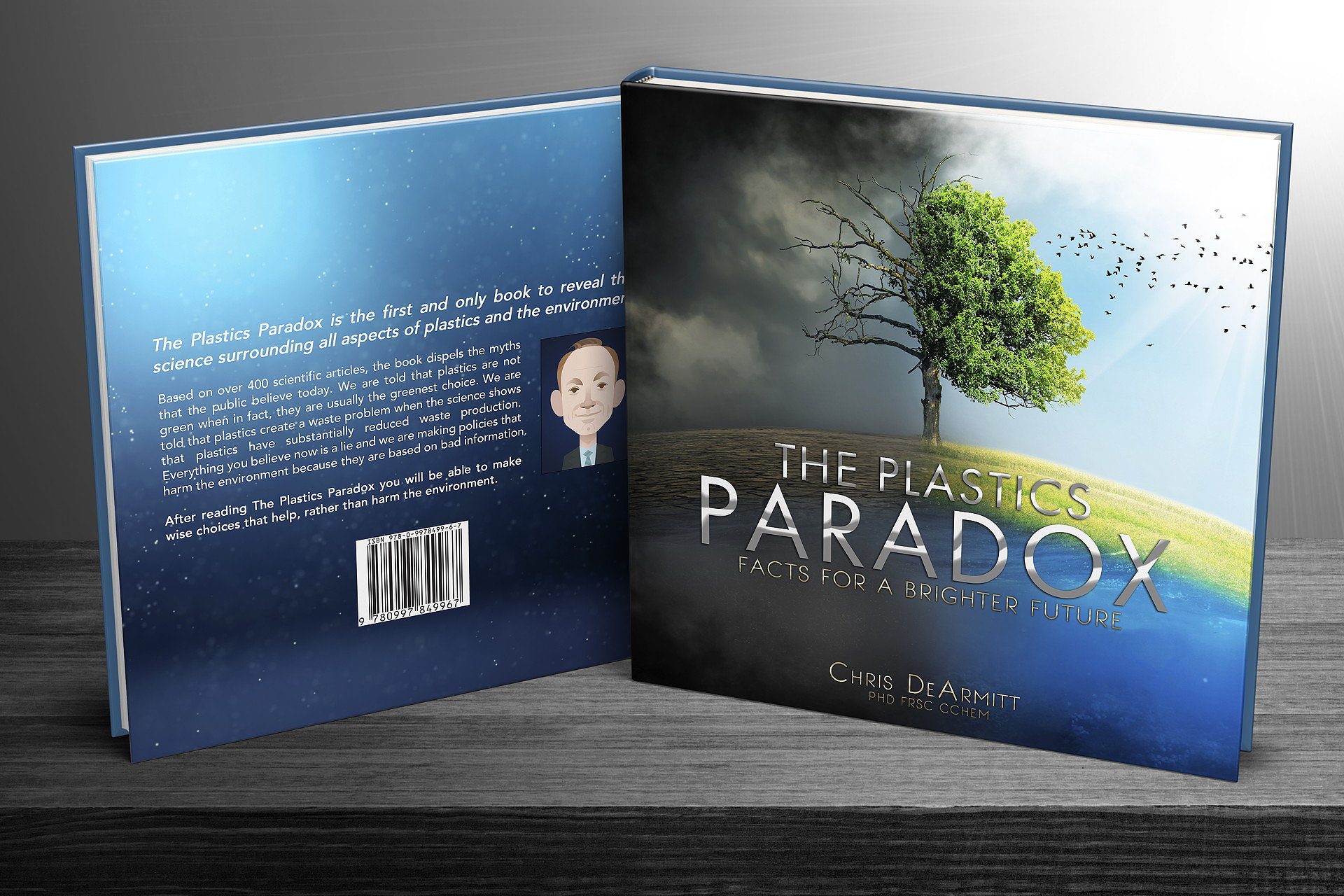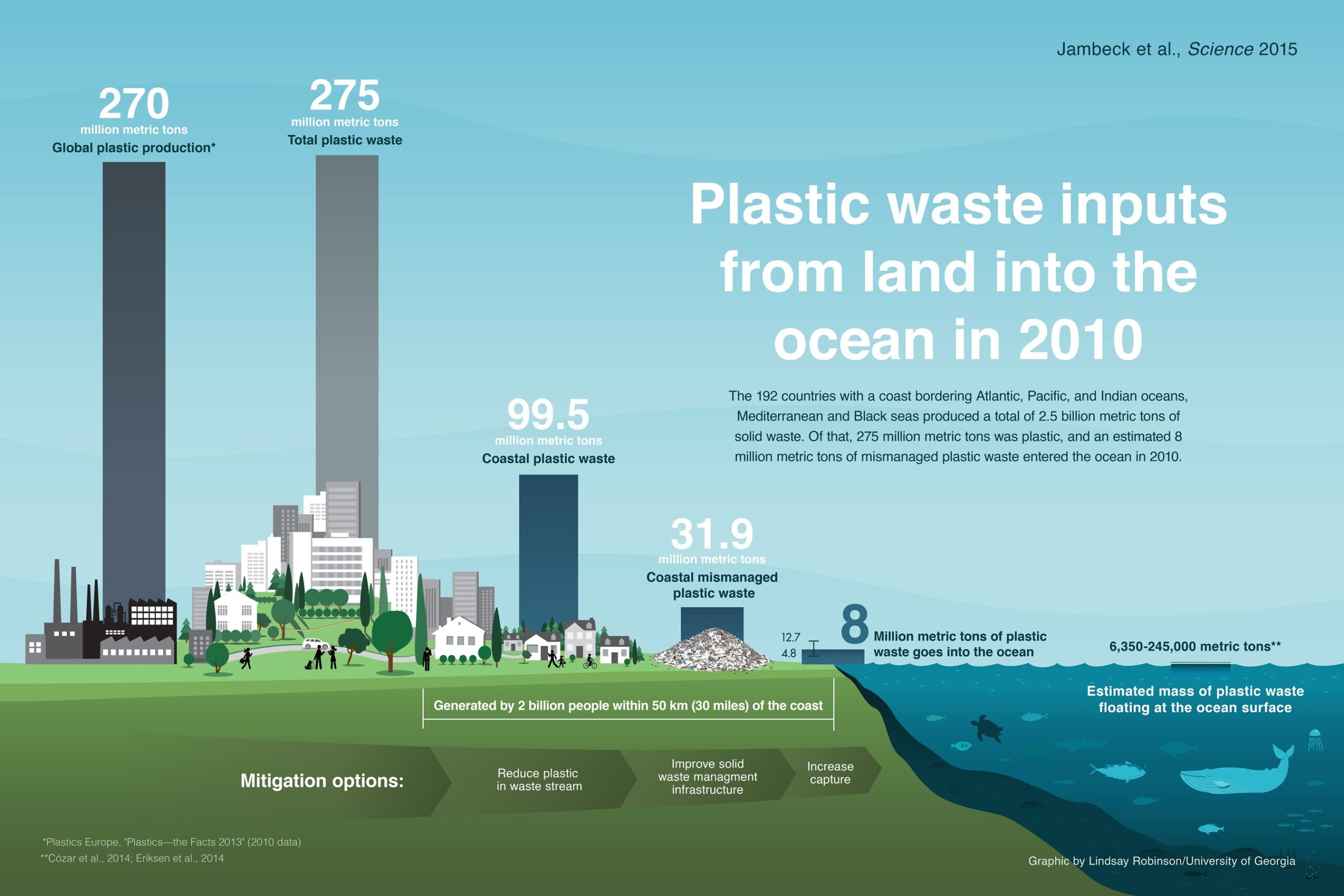MORE PLASTIC THAN FISH BY 2050?
Evidence & Perspective from the Leading INDEPENDENT Expert
Will there be more plastic than fish in the ocean by 2050? Is it true to false? See the evidence here.
More Plastic than Fish by 2050!
Truth or Scare?
The Ellen MacArthur Foundation claims that there will be more plastic than fish in the ocean by 2050:
“The best research currently available estimates that there are over 150 million tonnes of plastics in the ocean today. In a business-as-usual scenario, the ocean is expected to contain 1 tonne of plastic for every 3 tonnes of fish by 2025, and by 2050, more plastics than fish (by weight).”
Other organizations including the WWF, WEF, Greenpeace, Plastic Soup, Surfers Against Sewage and UNEP have repeated the claim. It’s a scary thought that captures our imagination and sticks in our minds. But is it true?
As a professional scientist and problem solver, I think it matters a great deal that we base our opinions on statements that are true. The reason for that is simple – it is very hard, or even impossible, to solve a problem based on bad data. So let’s take a look at the data…

Media Fact-Checks on the More Plastic than Fish by 2050 Claim
Most news sites blindly repeated the claim without ever fact-checking it, but some news sites published investigations. For example, the BBC had this to say after conducting their investigation:
“So how much plastic is there in the ocean, and how much will there be in 2050? We don’t know, but probably a lot. How many fish? We don’t really know but certainly a lot. And when will one overtake the other? We definitely do not know.”
The BBC interviewed the authors of the studies that the Ellen MacArthur foundation had based their calculations on and those scientists were not at all supportive of the conclusions drawn by the Foundation.
Jenna Jambeck, the scientist who estimated the amount of plastic expected to be in the ocean by 2025 did not support the Foundation decision to extrapolate the amount out to 2050. She was not convinced that such an extrapolation was valid.
Jennings who authored the study estimating the amount of fish had this to say:
“We’re not absolutely confident in our methods to determine what proportion of this is fish at the moment…it’s a very uncertain number to predict.”
The CBC/Radio Canada conducted their own investigative and few years later, in 2019 and the journalist concluded:
“What can be said with certainty is that there is already far too much plastic in the world’s oceans. But comparing the weight of the garbage to the marine life is, at best, fishy business.”
Summary of Media Fact-Checks on “More Plastic than Fish”
As we have just seen, the BBC investigated the story in 2016 and found that it did not stand up to scrutiny. They found the there is no evidence to support the claim and that the authors of the scientific articles that the Ellen MacArthur Foundation cited were not convinced either.
Then, again in 2019, the CBC conducted their own fact-check. Just as the BBC found, the CBC concluded that there was no evidence to support the claim.
As the story is not supported by evidence and as the story has been debunked twice we might ask why so-called “environmental” groups continue to promote it on their websites. Why have they not removed the story in the many years since it was debunked not once but twice?
Both fact-checks concluded that there’s probably a huge amount of plastic in the oceans, so we might wonder whether it makes any difference whether there’s more plastic than fish. As a scientist, I would argue that it does make a difference and the reasons will become clear when we re-examine the story in light of new evidence.
A New Examination of the “more plastic than fish in the sea by 2050” Story
The Ellen MacArthur Foundation’s report makes several claims and assumptions, so let us examine each one in turn. If even one of these points is unsubstantiated or false, then the “more plastic than fish in the ocean by 2050” claim is dispelled once and for all.
I am impressed that some journalists looked into this, but they were not able to show us the whole picture in part because they were not scientists or experts in the field and secondly because new information has come to light in the interim.
Let us now take a fresh, independent look at the statement from the Ellen MacArthur Foundation report:
“Each year, at least 8 million tonnes of plastics leak into the ocean — which is equivalent to dumping the contents of one garbage truck into the ocean every minute. If no action is taken, this is expected to increase to two per minute by 2030 and four per minute by 2050. Estimates suggest that plastic packaging represents the major share of this leakage. The best research currently available estimates that there are over 150 million tonnes of plastics in the ocean today. In a business-as-usual scenario, the ocean is expected to contain 1 tonne of plastic for every 3 tonnes of fish by 2025, and by 2050, more plastics than fish (by weight).”
The statement contains five main points:
• First, they claim that there is 150 million tons of plastic in the oceans already
• Secondly, they claim that the amount of plastic grows by over 8 million tons per year
• Thirdly, they claim that the amount is growing exponentially
• Fourthly, implicit in their calculation is that none of the plastic degrades and vanishes
• Finally, they claim that the total amount of fish in the oceans is 800-900 million tons
If any on those items is not solid or disproven, then the “more plastic than fish” claim is false. Now we will look at each of these five points in turn to see whether they are correct.
Point One – 150 million tons in the ocean now
The Ellen MacArthur report says “The best research currently available estimates that there are over 150 million tonnes of plastics in the ocean today.” – however, the citation they give is not peer-reviewed and does not give actual measurements. Instead, the number appears to be a wild guess based on the estimate that 8 million tons of plastic entering the ocean per year. The guess is based on taking the total amount of plastic material within a thirty miles (50km) of the shoreline and assuming that a certain percentage of it will somehow end up in the ocean.
That is pure guesswork, not solid science. In the next section addressing point 2, we will show that the 8 million tons number is now known to be a gross overestimate.
Ellen MacArthur Foundation cites this study for the 150 million tons of plastic already in the oceans – Ocean Conservancy and McKinsey Center for Business and Environment, Stemming the Tide: Land-based strategies for a plastic-free ocean (2015).
There is no scientific basis for the 150 million tons claim
Point Two – 8 million tons added per year
The Ellen MacArthur Foundation claimed that there over 8 million tons of plastic will enter the oceans per year. Again, the number was based on the work of Jambeck who assumed that a proportion of all plastic within 30 miles (50km) of the coast will somehow end up in the ocean. In contrast, a new peer-reviewed scientific study found that number to be false due to a serious mistake in the calculations. The best estimate for microplastics entering the oceans from rivers is now down from 8-12 million tons per year to just ~6000 tons per year. Whereas 8-12 million tons a year would be an emergency. The figure of 6000 tons still leaves room for improvement, but it does not constitute an emergency.
Weiss et al., The missing ocean plastic sink: Gone with the rivers, Science, 373 (6550), pp 107-111, 2021
A layperson’s explanation from the scientists can be found free of charge in the article and video interview here:
The ocean plastic sink that went away with the rivers
A new study estimates the amount of plastic coming from the fishing industry is much higher than that coming from land, which highlights why it is so important to make policy based on accurate data. We now know that ocean plastic coming from land is just 14%, compared to 86% coming from fishing activities, so the latter is is where we must focus our attention.
“We estimate that industrial trawl, purse-seine and pelagic longline fisheries operated 2.1 Mt of plastic gear over 2018 to obtain 49.7 Mt of retained and discarded catch, representing 74% of industrial marine capture globally. The median estimate for plastic gear lost during the use of these gear types was 48.4 kt (95% confidence interval: 28.4–99.5 kt). This estimate excludes abandoned and discarded gear.”
B. Kuczenski et al., Plastic gear loss estimates from remote observation of industrial fishing activity, Fish & Fisheries, 23 (1), 22-33, 2022
“Once a global map was produced from the “corrected” model observations, the total amount of plastic was aggregated. Between three model input scenarios, the mass of plastic floating on the ocean surface was estimated to be between 93 300 and 236 000 tonnes. However, the most conservative estimate for plastic emissions in 2010 was 4.8 million tonnes – two orders of magnitude higher. Errors may explain the difference between these two estimates.”
McAdam, Plastic in the ocean: How much is out there?, significancemagazine.com, October 2017
Claim 2 is incorrect and is too high by a factor of ~100-1000 times
Point Three – amount in the ocean increasing exponentially
The Ellen MacArthur report assumed that the amount of plastic entering the ocean would increase exponentially as the amount of plastic produced increased over time. Eight peer-reviewed studies show no increase in ocean microplastic for five decades despite production continuing to grow. It has been scientifically proven that the amount of plastic entering the oceans does not increase simply because the amount of plastic manufactured increases. Instead, the amount entering the oceans depends on how well or how badly we manage the waste we create. Note that the Galgani citation below reviews 8 separate scientific publications all showing no change in ocean plastic amounts for decades.
Richard C. Thompson et al., Lost at Sea: Where Is All the Plastic?, Science, 304 (5672), p838, 2004
F. Galgani et al., Are litter, plastic and microplastic quantities increasing in the ocean?, Microplastics and Nanoplastics, 1 (2), 2021
Claim three is incorrect
Point Four – plastic is only added and never degrades
The report assumed that all of the plastic ever entering the oceans would remain there forever and accumulate. In fact, there are thousands of scientific, peer-reviewed publications spanning decades all showing that plastics degrade and rather rapidly. This occurs even in the sea. The global market for additives to prevent plastics degrading is in the billions of dollars per year. No-one would be spending billions of dollars on stabilizers for plastics if they were stable. There is a page dedicated to dispelling the myth that plastics do not degrade here.
Point four has been disproven
Point Five – amount of fish is ~900 million tons
The report claimed that the amount of fish in the oceans is 800-900 million tons. The source they cited was:
Jennings et al., Global-scale predictions of community and ecosystem properties from simple ecological theory, Proceedings of the Royal Society B., 275, 1375–1383, 2008
The publication took a wild guess at the amount of fish, not by measuring fish but by estimating the amount of phytoplankton i.e. fish food there is from satellite data. There is no direct evidence that the amount of fish in the oceans is 800-900 million tons. In fact, the author Jennings, now believes that the number is far greater. This study says that the actual amount of fish is at least 10 times higher than the older estimate.
“With a current estimate of ~1,000 million tons, mesopelagic fishes likely dominate the world total fishes biomass. However, recent acoustic observations show that mesopelagic fishes biomass could be significantly larger than the current estimate. Here we combine modelling and a sensitivity analysis of the acoustic observations from the Malaspina 2010 Circumnavigation Expedition to show that the previous estimate needs to be revised to at least one order of magnitude higher.”
Point five is found to be in error
Conclusions of this Investigation
The BBC and CBC fact-checks both concluded that the claim was not supported by evidence. The present investigation, this time by a professional scientist, reveals more than the reporters were able to uncover.
Of the five points forming the foundation for the remarkable claim from The Ellen MacArthur Foundation, it is now clear that none of them stand up to scrutiny. The basis for the claim is non-existent which makes the statement itself a fabrication. The message we hear is that there are millions of tons of plastic entering the oceans every year from rivers when the latest estimate is far lower.

Conclusions about Plastic Fish in the Ocean
Any organization that genuinely cared about the environment and our oceans would rejoice at the news that there are not millions of tons of microplastic entering our oceans from land and that the amount is much, much lower at around 6000 tons. This huge reduction should be front page news and the NGOs should all be sharing this wonderful news with the public.
On the other hand, if the true motive for the NGOs is spreading falsehoods to get our donations and make themselves rich, then they would not rejoice, they would not share this news and they would not update their websites to reflect the truth. Which of these behaviours have we witnessed?
These are some of the many organizations that have chosen to keep spreading the more plastic than fish myth despite it being debunked by the BBC in 2016, the CBC in 2019 and now again in 2022. I have saved copies of each page in case they are updated.
Ellen MacArthur Foundation – Lobbying for policy change
Greenpeace – Donate link on page
Plastic Soup – Donate link on page
Surfers Against Sewage – Donate link on page
Earthday – Donate link on page
WEF – Lobbying for policy change
UNEP – Lobbying for policy change
Despite the fact that the claim never had any solid evidence and despite it being debunked, NGO sites still promote this myth on their websites next to the word “donate”. Why do they choose to profit from fiction that has been debunked for many years? The other type of group still sharing this myth is groups fighting for policy change. Why would groups want policies based on fiction? Are those likely to be wise and helpful policies? Who is funding these groups and what are their motives?
Could their failure to remove mention of this myth simply be an oversight? The evidence would suggest not. Such groups tell us that we’re drowning in plastics when in fact plastics make up 0.5% of materials and waste. We were told that a turtle had a plastic straw up its nose, but that has now been debunked. NGOs told us that plastics are a major source of global warming but once again, that is in contradiction with the science. In fact, the majority of claims made against plastics turn out to be false. The former President of Greenpeace said that he left in disgust claiming that they had abandoned facts and the environment in favor of selling fictional stories to get donations. Could it be that other organizations followed the same path? It would not be the first time that money had corrupted people who started off with good intentions.
We cannot make wise decisions for future generations based on fiction. From these examples and others, including those outlined by the former President of Greenpeace, NGOs are creating fictional stories that are not helping the environment but instead they are tricking kind-hearted people into parting with their hard-earned money.
Once again, we see that the demonization of plastics is unwarranted and distracts the public from the real issues. Want to know more facts about plastics and the environment? If you really care about our future, the read The Plastics Paradox book, which is free here. If you only have 20 minutes to spare then watch The Great Plastics Distraction video on YouTube which will shock you because for most people, it is the first time they have seen the truth.
“you can be for the environment, or against plastics, but not both”.

Dr. Chris DeArmitt is a renowned independent scientist and keynote speaker with decades of experience solving tough technical challenges for some of the world’s leading companies. He is a Fellow of the Royal Society of Chemistry and Fellow of the Institute of Materials, Minerals and Mining. He is also a Chartered Chemist with a long list of publications, presentations and patents to his name. His review of the science around plastics and the environment was performed unpaid to preserve impartiality.
Income 2024 : ~ 60% NAICS 424690 Chemicals, ~30% NAICS 423990 Durable Goods, ~10% NAICS 541110 Legal, ~0% NAICS 325211 Plastics Composition varies over time




